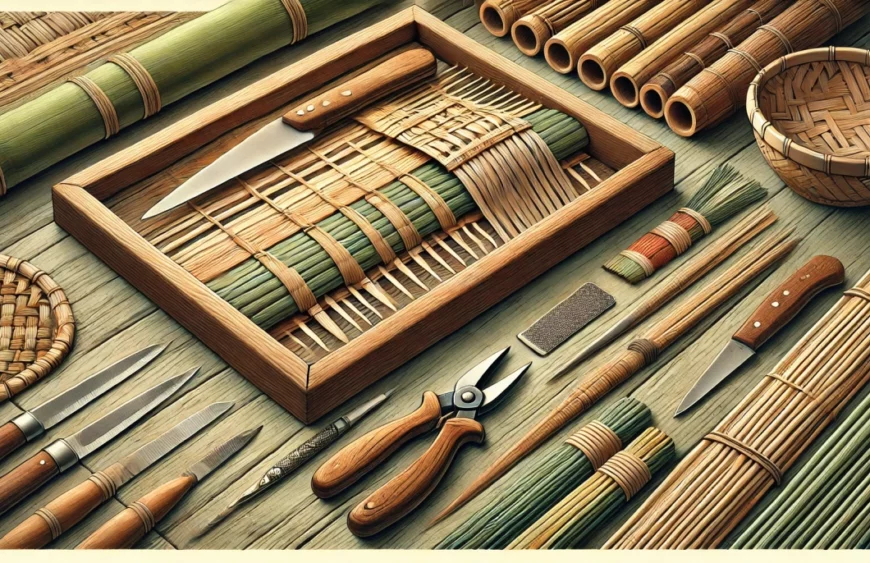竹編み入門ガイド

Bamboo weaving, an age-old folk craft, once held a significant place in daily life. While its prominence has faded over time, the charm and artistry of bamboo weaving still captivate many. Unfortunately, professional tutorials and resources are increasingly scarce. This guide will introduce you to the basics of bamboo weaving, covering key processes and techniques to help you appreciate this timeless art form.
The Journey of Bamboo Weaving
From splitting bamboo to the finished product, bamboo weaving involves 10–30 meticulous steps. These include splitting bamboo, dyeing, weaving, and adding handles or finishing touches. Let’s explore these steps in detail, along with diagrams of nine fundamental weaving methods and seven finishing techniques.
Step 1: Splitting Bamboo
Splitting bamboo, known as “破篾 (pò miè),” is the first and most critical step. Here’s how it’s done:
- Splitting the Bamboo:
Use a bamboo knife to split a bamboo stalk into thin strips, commonly in sizes of 1mm, 2mm, 3mm, or 5mm. - Smoothing with a Knife:
A tool called the “剑门刀 (jiàn mén dāo)” ensures uniform width. Bamboo strips are smoothed for even thickness and silk-like texture through scraping and polishing, often repeated three to four times. - Finishing Touches:
Round knives are used to remove sharp edges, ensuring the strips are safe to handle and visually appealing.
Step 2: Dyeing and Carbonization
Depending on the design, the bamboo strips can be dyed, carbonized, or treated to prevent insect damage. Once prepared, the strips are dried to retain their color and durability.
Step 3: Weaving
The weaving stage involves employing different techniques based on the object being crafted. Bamboo weaving has evolved over centuries into flat weaving, three-dimensional weaving, and warp-weft weaving, forming the foundation for countless intricate designs.
Step 4: Adding Handles and Final Touches
Handles, rims, or additional decorative elements are installed to complete the piece, making it functional and visually striking.
Essential Tools for Bamboo Weaving
Mastering bamboo weaving requires specialized tools:
- Bamboo Knife: For splitting bamboo (25 cm long).
- Smoothing Knife (剑门刀): Ensures uniform strip width.
- Small Saw: For cutting bamboo sections (55 cm long).
- Files (尖锉 & 平锉): Used to shape and smooth the bamboo edges.
- Compasses and Gauges: For measuring dimensions accurately.
- Drill Rods and Hammers: Used for assembly and drilling holes.
Nine Fundamental Weaving Techniques
- Basic Weave (一挑一):
Alternating over-and-under patterns with bamboo strips for simple, balanced designs. - Diagonal Weave:
Create patterns by overlapping strips at angles, typically in “2 over, 2 under” formations. - Square Weave:
A symmetrical, geometric weave that starts at the center and expands outward. - Step Weave:
Gradual shifts in strip placement create a staircase effect, ideal for intricate designs. - Triangular Weave:
This technique begins with three strips forming triangles, gradually adding layers for complexity. - Double Triangle Weave:
An advanced variation of the triangular weave, adding depth and dimension. - Hexagonal Weave:
Start with three strips and expand into six-sided patterns, popular for baskets. - Round Weave:
Overlapping four strips in circular patterns for rounded bases or edges. - Chrysanthemum Weave:
Radiating strips from a central point create a floral effect, symbolizing tradition and beauty.
Seven Finishing Techniques
Finishing techniques ensure durability and aesthetic appeal. These include folding, trimming excess bamboo, and incorporating frames or reinforcements for sturdiness. For example:
- Inner and Outer Frames: Add structural stability and a polished look.
- Binding with Rattan or Vine: Secure the ends for a neat and professional finish.
The Timeless Beauty of Bamboo Weaving
Though modern times have seen bamboo weaving diminish in urban areas, rural communities continue to cherish its practicality and artistry. Beyond its function, bamboo weaving reflects the wisdom and ingenuity of generations past. In embracing this craft, we reconnect with a tradition that enriches our lives with beauty, sustainability, and creativity.
Would you like to learn more or try your hand at bamboo weaving? Let’s keep this ancient art alive!

